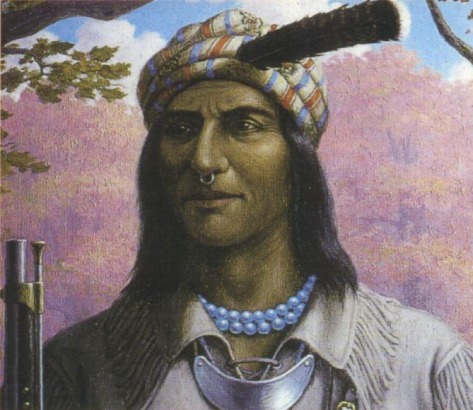TECUMSEH (b.1768 (?) - d. October 5, 1813)

Tecumseh's father, Pukeshinwau, was of the Kispoko division of the Shawnee tribe, and was a member of the clan belonging to the celestial panther, Meshepeshe; Tecumseh's mother, Methoataaskee, belonged to the Pekowi division and the turtle clan. As divisional identity and clan identity descended patrilineally, Tecumseh and his siblings would be Kispoko Shawnees of the panther clan.
It is estimated that Tecumseh was born in 1768, the fourth child. Pukeshinwau and Methoataaskee had eight children: Cheeseekau; Tecumpease, a girl; Sauawaseekau; Tecumseh; Nehaaseemoo; and a remarkable birth of triplets, one died, the other two were named Kumskaukau and Laloeshiga, who was known as a disgrace and later adopted the name Tenskwatawa ("Open Door") before adopting the name Lalawethika and was known as the Prophet.
Tecumseh's childhood was marred by the savageries of heated war between the Natives and the White settlers encroaching on their land, burning their home and sending their families fleeing. It would have been understandable if Tecumseh had grown into a hateful man, but those who knew him testified that Tecumseh was a man of generosity who would not deny an appeal to humanity.
Tecumseh's name meant "Shooting Star" and as names were chosen based on clan and his clan was of the starry, brilliant panther of the sky, it could be more appropriately interpreted as "A Panther Crossing the Sky". Tecumseh was a giant among men, literally; he stood five-foot ten at a time when most White men were five-foot-six or less. As an infant, he spent the day on a cradle board with small objects placed against his limbs so they, as well as his back, would grow straight and strong. Because of his straightness of posture, he appeared even taller. Tecumseh was an uncommonly handsome man, powerfully and athletically built. He was also articulate as well as keenly intelligent. He was known to be a brave and fierce warrior, a skilled hunter, and a fiery orator.
By the signing of the Greenville Treaty, Tecumseh had earned the position of war and civil chief of his people by his own merit, as all chiefs were chosen.

Throughout his adult years, Tecumseh would prove himself to be a capable and dignified leader. Leading up to the War of 1812. Tecumseh would spend his days traveling, speaking to other Native groups. Tecumseh is known for having brought together the largest confederacy of Native peoples in history and at a time when their people were suffering great losses. Not only did Tecumseh accomplish this, such an incredible feat, but he also brought together peoples who had never before been connected by a confederacy.
Tecumseh aligned his men with the British in Canada for the War of 1812. He had hope that, with their assistance, he and his people would be able to regain some of the lands in the Midwest which had been wrestled from their grasp in previous years; if he helped the British fight along the Canadian frontier, they could launch offensive operations which would give the Native peoples their lands back.
Tecumseh fought bravely in the early part of the war, fiercely fighting the Americans while trying to keep his warriors in line. He was involved in many operations and, as the leader of the Confederacy, Tecumseh was held in high esteem by prominent British leaders, such as Maj.-Gen. Isaac Brock.
Tecumseh was approaching deity by the time of his death at the Battle of the Thames.
On October 5, 1813, the great Chief Tecumseh met his end at the Thames. As the British deserted their Native allies at the Battle of the Thames, Tecumseh and his warriors found bravely against the Americans, unknowing of their new vulnerability. The American men were better equipped and filled with a hunger for revenge in the name of the men who were slaughtered at the River Raisin Massacre.
Tecumseh fell, supposedly from a bullet wound. It was rumoured that Andrew Jackson was the killer of Tecumseh, though William Henry Harrison often took credit for the slaying as well. The Americans butchered a body lying on the field, whom they believed to be Tecumseh, and rendered it unrecognizable. Some warriors who had fought alongside Tecumseh claimed that this was not the chief and that his body had been falsely identified; the Americans had killed a man with many decorations, while Tecumseh was dressed plainly, with only a British medal. It is possible that the Americans had identified him falsely, with the belief that the great chief would easily recognizable by his dress.
It is unknown what really happened to the body of Tecumseh, though there are numerous stories. It is generally believed that the body of the great Tecumseh still lies in the area.

